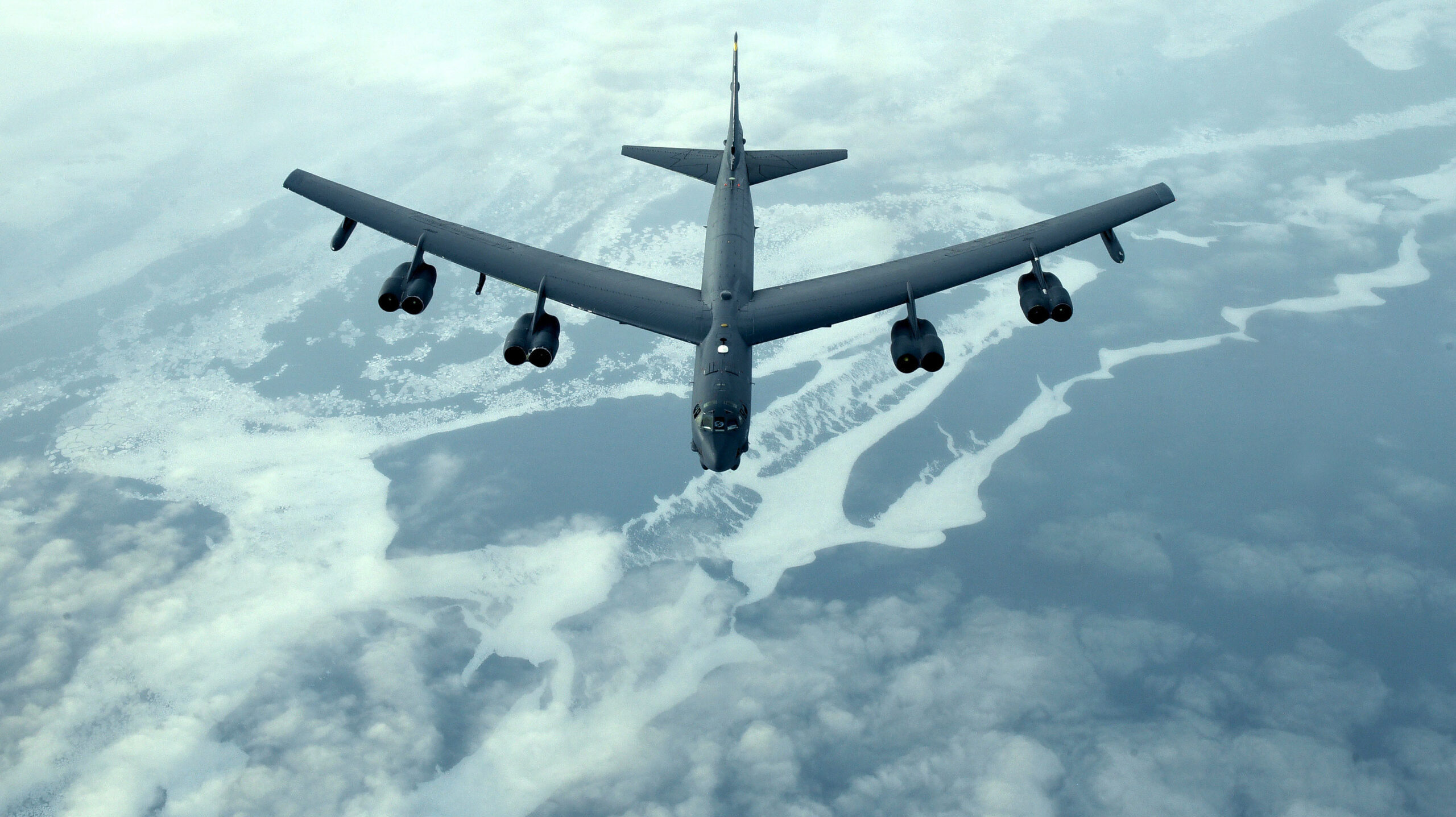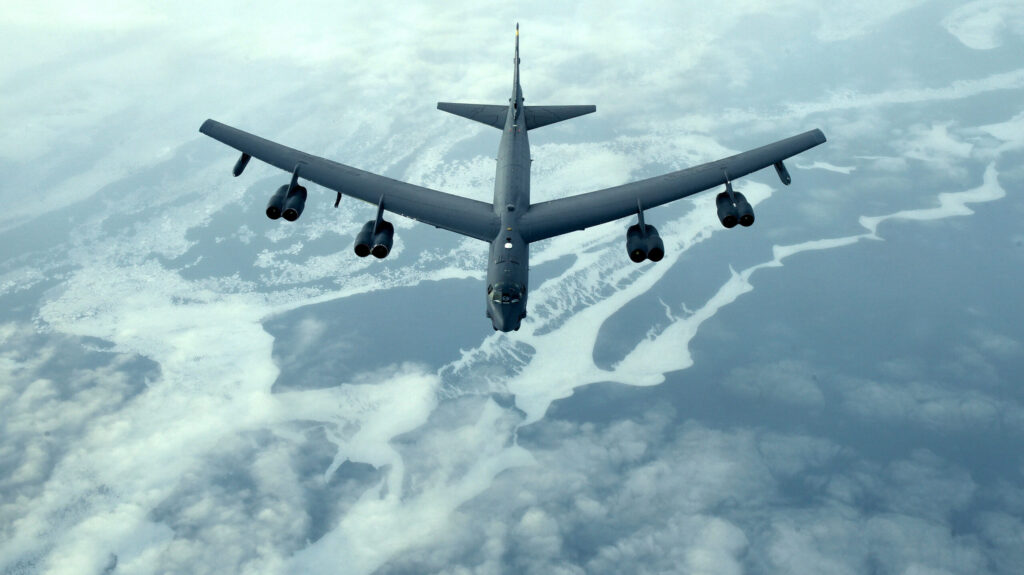
A U.S. Air Force B-52H Stratofortress assigned to the 5th Bomb Wing at Minot Air Force Base, North Dakota, flies alongside a KC-10 Extender from the 305th Air Mobility Wing, Joint Base McGuire-Dix-Lakehurst, NJ, after receiving fuel, Jan. 6, 2021. Air Mobility Command’s nuclear mission is to sustain an effective nuclear response and maintain a modern, robust, flexible and ready nuclear deterrent force. (U.S. Air Force photo by Staff Sgt. Stephanie Serrano)
At the recent US Strategic Command (STRATCOM) symposium, Congressman John Garamondi (D-CA) spoke on one of the panels and suggested that the US should stop developing the Sentinel intercontinental ballistic missile – a position he has long held. Interestingly, he also called on the military to put nuclear bombers back on alert if the nuclear threat is as serious as STRATCOM claims.
While we don’t share his views on Sentinel, we certainly agree with his view that nuclear-capable bombers should be put back on alert. This is long overdue.
Russia already has a tactical nuclear arsenal ten times larger than the USA. China is also expected to be the USA’s nuclear equal by 2035. And North Korea is building a nuclear arsenal that, according to dictator Kim Jong-un, will grow “exponentially” in the coming years.
Given that China and Russia are entering into a borderless friendship and North Korea a military alliance, NATO Secretary General Jens Stoltenberg hinted in June that Russia could soon provide North Korea and possibly China with technical assistance and fissile nuclear material – needed to produce more nuclear warheads – in return for help in the fight against Ukraine.
President Joe Biden is aware of the growing threat. According to the New York Times, Biden signed new strategic guidelines in March that instructed the U.S. to prepare for coordinated nuclear threats from China, Russia and North Korea.
The long-term consequence of these closer ties is that an axis of autocracy will field a collective nuclear arsenal that far outweighs that of the United States. This is a recipe for coercion, as all three rivals may be able to control American policy with a nuclear saber. Should the U.S. military intervene in a Chinese invasion of Taiwan, for example, Beijing will surely try to force the U.S. to sit out the conflict by escalating nuclear threats—while North Korea and Russia look for an opportunity to exploit the situation.
To make matters worse, the United States, which has up to 1,550 operational strategic nuclear weapons in its intercontinental ballistic missiles (ICBMs), nuclear bombers and ballistic missile submarines, can only rely on 400 ICBMs and part of its Ohio-class submarine fleet for its daily operational readiness.
Today, the country’s nuclear bombers are not on what is known as “alert,” meaning that the B-52 and B-2 bombers are loaded with their nuclear weapons and crews are standing by to quickly get the jets airborne and to safety ahead of a possible attack. In the event of a crisis, it would take the Air Force days or more to get the bomber fleet back on alert, but it could only maintain it for a short time before collapsing. That leaves the country’s 46 nuclear-capable B-52 and 19 B-2 bombers easy prey for a conventional or nuclear attack.
Restarting the country’s nuclear-capable bombers – even just some of them – is necessary to ensure their survival and to signal to China and Russia that the United States is serious about nuclear deterrence.
This problem is not new. In 2021, then-commander of the US Strategic Command, Admiral Charles Richard, testified before the Senate Armed Services Committee that he would ask for the bombers to be put back on alert if the country lost its intercontinental ballistic missile force.
Lieutenant General James Dawkins, then-Air Force vice chief of staff for strategic deterrence and nuclear integration, explained shortly thereafter that the Air Force could not put even some bombers back on alert for more than a short period of time because “you need more pilots, more security (personnel) and more maintenance personnel, more bombers, improvements to the (alert) infrastructure, and more tanker aircraft.”
The needs and challenges are even greater today. The Air Force has fewer nuclear-capable bombers than at any time in its history and lacks the crew to train and sustain such a mission. That doesn’t even take into account the security forces required: airmen to guard the jets, maintenance personnel to repair them and tanker aircraft to provide in-flight refueling.
How can this problem be solved? In the long term, the country needs to buy several hundred bombers. This requires the air force to focus on long-range strikes, which is arguably its most important mission. But realistically, the production of such systems takes too long to manage the short-term risk.
The short-term solution is to dramatically increase the number of trained bomber crews, strengthen the necessary security forces, and train the necessary maintenance and support personnel. The same applies to the tanker fleet that supports bomber operations.
This will not be cheap. It will require prioritizing nuclear capabilities over other needs in the defense budget and probably over non-defense spending as well. This will not be easy. Given the recruitment difficulties facing the Air Force and the timelines for training aircrew, it will require a hard push today.
But these problems can be overcome if the will is there – and that will is necessary, because a strong nuclear deterrent is literally vital to America’s security and prosperity.
When President George HW Bush lifted the bomber fleet’s alert status on September 27, 1991, it had been on alert for 12,414 days straight. Today, a week may be too much for a fleet that is one-tenth the size it was in 1991. Unfortunately, the bomber fleet is now a shadow of its former self.
But it doesn’t have to be that way. With the right focus and attention, we can ensure that a key part of America’s strategic deterrence remains up to date.
Dr. Adam Lowther is vice president for research at the National Institute for Deterrence Studies. He spent more than two decades in uniform working on nuclear issues as an Air Force and Army official. He is also the host of the NucleCast podcast.
Lt. Col. Derek Williams is a B-52 weapons systems officer in the U.S. Air Force and a graduate of the Sandia National Laboratories Weapons Internship Program.
The views expressed are those of the authors and do not reflect the official policies or positions of the U.S. Government, Department of Defense, U.S. Air Force, United States Space Force, or U.S. Strategic Command.

